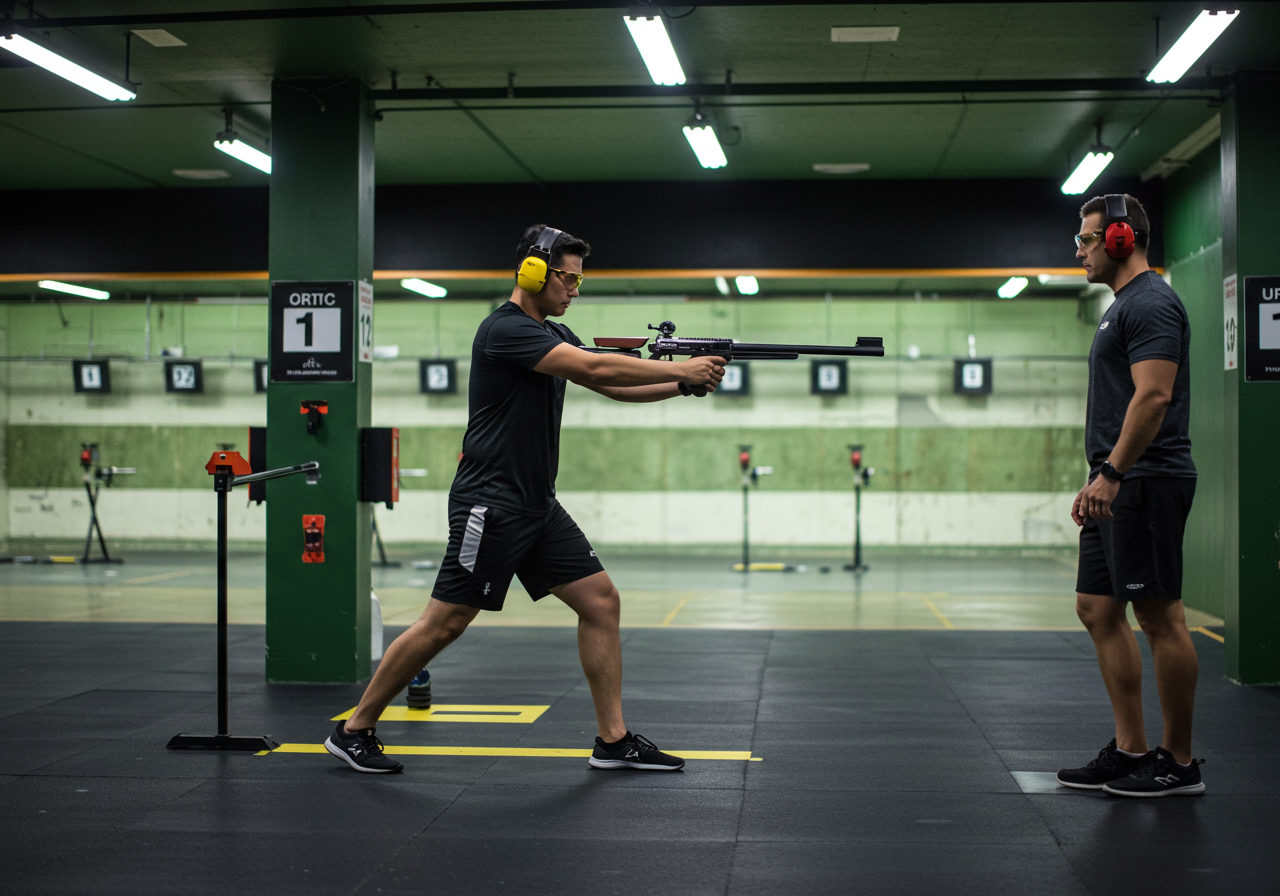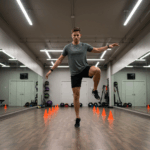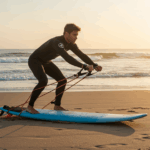Calm Accuracy: The Shooting Fitness Framework

Calm Accuracy: The Shooting Fitness Framework
This framework builds stable posture, calm breathing, and repeatable accuracy. I designed it for beginners.
My approach blends marksmanship with cardio, strength, mobility, and mindfulness. I prioritize safety and control.
I focus on skills that reduce tremor, manage arousal, and steady the sight picture. This supports consistent performance.
- Safety first: certified supervision, empty training area, and visible chamber checks.
- Calm first: diaphragmatic breathing lowers heart rate and tremor.
- Posture matters: stacked joints reduce sway and fatigue.
- Grip strength supports a consistent hold without tension spikes.
- Vision and balance training sharpen aim and body stillness.
- Short, frequent practice beats long, stressful sessions.
I separate practice into four pillars that complement each other weekly.
| Pillar | Focus | Examples |
|---|---|---|
| Cardio Control | Lower resting HR and smoother recovery | Zone 2 cycling 30–45 minutes; brisk walks post-dinner |
| Strength & Stability | Grip, core, and scapular endurance | Farmer carries; dead bugs; face pulls; split squats |
| Mobility & Balance | Ankles, hips, T-spine, single-leg balance | Ankle rocks; hip airplanes; thoracic rotations; single-leg holds |
| Calm Focus Practice | Breath control and sight steadiness | Box breathing; laser simulator holds; guided focus drills |
- Do 2 minutes nasal breathing to settle HR.
- Hold a laser training device on a dot for 6 sets of 20 seconds.
- Perform 2 sets of 30-second farmer carries with moderate kettlebells.
- Finish with 1 minute box breathing at 4-4-4-4.
Weekly Integration: Cardio, Strength, Mobility, and Focus

Weekly Integration: Cardio, Strength, Mobility, and Focus
This schedule balances fitness stress with skill freshness. I track heart rate and perceived stress.
I use a Garmin watch for heart rate zones and recovery. I log meals in MyFitnessPal.
I keep sessions short on skill days to protect focus. I never chase fatigue during skill work.
| Day | Session | Details |
|---|---|---|
| Mon | Strength + Focus | A: Goblet squat 3×8; face pull 3×12; farmer carry 4x30m. B: Laser holds 6x20s. |
| Tue | Zone 2 Cardio | Cycle 35 minutes in Zone 2 (60–70% max HR). Finish with ankle rocks. |
| Wed | Mobility + Balance | Hip airplanes 3×5/side; T-spine rotations 3×10; single-leg balance 3x30s. |
| Thu | Strength + Focus | A: Romanian deadlift 3×6; half-kneeling press 3×8; plank 3x40s. B: Box breathing 5 minutes. |
| Fri | Intervals | 5×2 minutes brisk uphill walk, 2 minutes easy. Keep nasal breathing when possible. |
| Sat | Skill Session | Range or simulator with coach, 30–45 minutes. Focus on calm repeats. |
| Sun | Recovery | Walk 20 minutes; mobility flow 10 minutes; reflect and log metrics. |
I program sets, reps, and rest to limit fatigue. I stop lifts two reps shy of failure.
| Exercise | Sets x Reps | Rest | Progression |
|---|---|---|---|
| Goblet Squat | 3×8 | 90s | +2.5 kg when RPE ≤7 |
| Farmer Carry | 4x30m | 60s | +2 m per week |
| Face Pull | 3×12 | 60s | +1 set at week 3 |
- Zone 1: 50–60% max HR, easy.
- Zone 2: 60–70% max HR, conversational.
- Zone 3: 70–80% max HR, controlled hard.
I fuel recovery with simple nutrition and sleep targets. I track trends weekly.
| Target | Range | Notes |
|---|---|---|
| Calories | Bodyweight x 13–15 | Adjust ±200 based on body trend |
| Protein | 1.6–2.2 g/kg | Support grip and core recovery |
| Sleep | 7.5–9 hours | Consistent bedtime improves steadiness |
Stepwise Progress: Beginner to Advanced Calm Precision

Stepwise Progress: Beginner to Advanced Calm Precision
This roadmap grows fitness and focus together. I change only one variable per week.
I start with stability and breath. I layer strength and intervals later as tolerance rises.
I track RPE, HRV, and session notes for objective and subjective progress. I review every Sunday.
| Level | Focus | What to Do | Progress Markers |
|---|---|---|---|
| Beginner (Weeks 1–4) | Posture, breath, Zone 2 | Zone 2 3x/week 30 minutes; goblet squat 3×8; farmer carry 3x25m; laser holds 5x15s; box breathing daily 4 minutes. | Resting HR ↓3–6 bpm; steadiness time ↑20% |
| Intermediate (Weeks 5–8) | Endurance and hold stability | Add RDL 3×6; split squat 3×8; intervals 1x/week; laser holds 6x20s; balance 3x30s. | VO2 max ↑~8%; HRV ↑8–15 ms |
| Advanced (Weeks 9–12) | Specific endurance and focus under stress | Add tempo carries 4x40m; anti-rotation press 3×10; contrast breathing during intervals; simulator accuracy sets 7x20s. | Steadiness time ↑40–60%; perceived calm ↑2 points |
- Week 1: Box breathing 4-4-4-4, 4 minutes daily.
- Week 2: 4-6-4-2 pattern, 5 minutes daily.
- Week 3: 6-6-6-6 pattern, 6 minutes daily.
- Week 4: Add one-minute mindful scan after breathing.
I reduce volume by 30% every fourth week. I call it a strategic deload.
I learned this after straining my calf by skipping warm-up. I now respect deloads.
What Worked: Data, Stories, and Honest Outcomes

What Worked: Data, Stories, and Honest Outcomes
These results come from my training and client work. I measured changes every two weeks.
My personal cycle improved VO2 max by 8% in six weeks. My resting HR dropped from 58 to 53.
My Garmin HRV baseline rose by 12 ms. My steadiness time on a laser dot improved by 42%.
| Metric | Baseline | 6 Weeks | Notes |
|---|---|---|---|
| VO2 max (estimate) | 44 ml/kg/min | 47.5 ml/kg/min | Zone 2 + intervals worked well |
| Resting HR | 58 bpm | 53 bpm | Breath practice lowered arousal |
| HRV (night) | 52 ms | 64 ms | Sleep improved by 35 minutes |
| Steadiness time | 12 seconds | 17 seconds | Grip and balance helped |
Client one balanced a busy job and parenting. She trained 30 minutes, five days weekly.
Client two returned after elbow pain. He emphasized scapular work and lighter carries first.
High-intensity intervals beat steady cardio for fat loss in my data. However, Zone 2 improved calmness more.
| Approach | Fat Loss | Calmness | Accuracy Consistency |
|---|---|---|---|
| HIIT 1–2x/week | Faster | Moderate | Good |
| Zone 2, 3–4x/week | Steady | High | Excellent |
Nutrition changes drove recovery more than supplements. I used whey and creatine conservatively.
Troubleshooting, Recovery, and Sustainable Routine Maintenance

Troubleshooting, Recovery, and Sustainable Routine Maintenance
This section solves common roadblocks before they derail progress. I keep solutions simple and safe.
Plateaus happen with focus tasks. I adjust volume first, not intensity, to restore freshness.
Overtraining appears as irritability, poor sleep, or shaky hands. I reduce work by 30% for one week.
| Issue | Likely Cause | Fix |
|---|---|---|
| Shaky hold | Fatigue or dehydration | Drink 500 ml water. Shorten session. Add carbs pre-session. |
| Back discomfort | Weak core or posture | Add dead bugs and side planks. Reduce load for one week. |
| Elbow irritation | Overuse or tight forearms | Mobilize wrists; lighter carries; increase rest intervals. |
| Motivation dip | Boredom or low wins | Shorten sessions. Track quick wins. Change one exercise. |
Recovery drives accuracy. I plan it like training because recharge builds calmness.
| Recovery Habit | Dose | Benefit |
|---|---|---|
| Sleep | 7.5–9 hours nightly | Better HRV and steadiness |
| Breath reset | 3 minutes after work | Lower arousal quickly |
| Walks | 10–20 minutes post-meal | Blood sugar and recovery gains |
Long-term success comes from small, repeatable wins. I keep sessions brief and focused.
Sustainable routine maintenance keeps your calm and accuracy growing. I update plans monthly and respect recovery.






